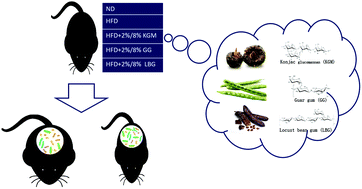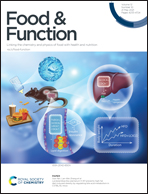Effects of three different mannans on obesity and gut microbiota in high-fat diet-fed C57BL/6J mice†
Abstract
To compare the effects of three mannans, Konjac glucomannan (KGM), guar gum (GG) and locust bean gum (LBG), on obesity and obesity-related metabolic disorders in mice fed with high-fat diet (HFD), and to investigate the potential modulation of gut microbiota, we performed a 14 week study on C57BL/6J mice fed a HFD with/without mannan supplementation. The results showed that supplementing 8% KGM, GG, and LBG to a HFD dramatically reduced the body weight gain and adipose accumulation, attenuated liver injury, and antagonized glycolipid metabolism and inflammation-related parameters of HFD-fed mice in different degrees. However, only LBG had such roles when the supplement dose was reduced to 2%. In addition, it was found that LBG required more time to exert its impacts on weight control and lipid metabolism. Furthermore, 16S rRNA gene sequencing of gut microbiota indicated that mannans with different structures and supplement doses affected the overall structure of the gut microbiota to a varying extent and specifically changed the abundance of some OTUs. Moreover, several OTUs belonging to the genera Muribaculum, Staphylococcus, [Eubacterium] fissicatena group, and Christensenella had a high correlation with obesity and obesity-related metabolic disorders of the host. In summary, all the three mannans had the potential to be used as alternative dietary supplements or functional foods to prevent obesity and obesity-related metabolic disorders induced by a HFD, but the effects of the dose and time varied, and the functions of the mannans were associated with their ability to regulate the gut microbiota.



 Please wait while we load your content...
Please wait while we load your content...